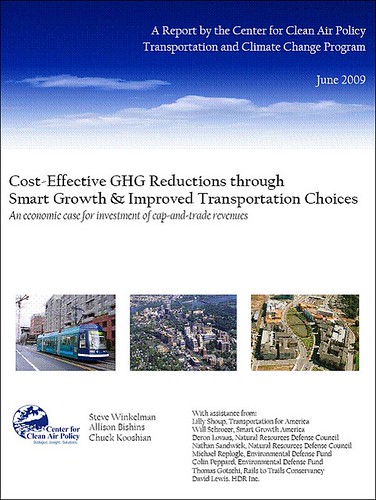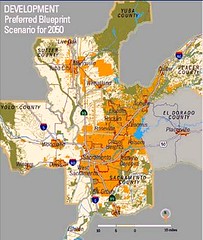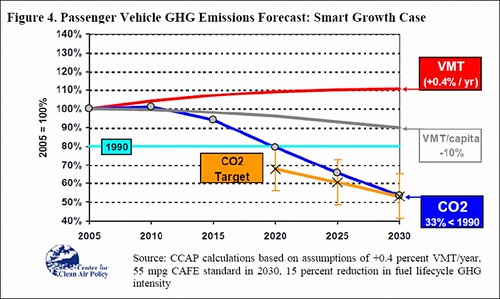New numbers prove smart growth reduces CO2, cost-effectively

Posted June 22, 2009 at 1:49PM
For the most part, the climate change establishment - whether in government, industry, or the environmental community - has ignored the potential of land use strategies to provide significant reductions in carbon emissions while also producing multiple other environmental, economic, and societal benefits. There have been grudging, passing mentions, usually at the end of some long report or other mainly about cap and trade schemes, power plants and fuel efficiency, but that's been about it.
Now, reducing power plant emissions and increasing vehicle fuel efficiency are hugely important strategies, as are getting more from renewable energy sources and green buildings, for that matter. But how's that working out so far, you might ask? The best that one can say is that the recession has driven carbon emissions down for the moment, and there is hope for incremental legislative progress. Meanwhile, the US continues to lag far, far behind Europe in controlling emissions.
It's quite possible that California's new land use and transportation planning law, SB375, has been a game-changer. As most readers probably know, that law, which was strongly supported by NRDC, requires the state's metro areas to adopt land use patterns that curb sprawl and reduce carbon emissions to meet specified targets.
Suddenly people who two years ago wouldn't give smart growth advocates the time of day are talking about things like transit-oriented development and growth boundaries (if they still haven't caught on to revitalization and walkability, unfortunately), and mainstream enviros are beginning to seek ways to increase neighborhood density instead of opposing it. People are looking to the coming federal transportation bill as a way to implement California's measures on a national scale. While you still won't hear much about any of this from the Really Big Thinkers on climate, it's happening in spite of them.
Which is a pretty long introduction to a new report that will make smart growth harder to ignore as a carbon-reducing strategy.  In particular, the Center for Clean Air Policy (CCAP) released a study last Friday documenting how comprehensive application of smart growth best practices and improved transportation choices can significantly reduce transportation emissions at a cost savings to society. The report makes a strong case for investing a portion of cap-and-trade revenues in smart growth. Here are some of the key findings:
In particular, the Center for Clean Air Policy (CCAP) released a study last Friday documenting how comprehensive application of smart growth best practices and improved transportation choices can significantly reduce transportation emissions at a cost savings to society. The report makes a strong case for investing a portion of cap-and-trade revenues in smart growth. Here are some of the key findings:
- Smart growth and smart transportation choices can reduce the amount Americans need to drive - as measured in vehicle miles traveled (VMT) - by 10 percent per capita from 2005 levels.
- A 10 percent reduction in per capita VMT would reduce annual transportation emissions by 145 million metric tons of carbon dioxide (MMTCO2) in the year 2030, equivalent to the annual emissions of about 30 million cars or 35 large coal plants.
- These reductions would equal approximately 6 percent of the 2030 greenhouse gas (GHG) reduction goal proposed in the American Clean Energy and Security Act.
The new study, titled Cost-Effective GHG Reductions through Smart Growth & Improved Transportation Choices: An economic case for strategic investment of cap-and-trade revenues, was authored by CCAP's Steve Winkelman, who has consistently produced great analytical work on these subjects, and his colleagues Allison Bishins and Chuck Kooshian. My NRDC colleagues Deron Lovaas and Nathan Sandwick, among others, provided advice and comments to the authors.
CCAP reviewed a number of reports and case studies from US cities and states that demonstrate how making smarter land use and transportation choices reduces emissions and saves money. Some examples:
- Sacramento projects savings of 7.2 MMT of CO2 by 2050, while saving $9 billion in infrastructure costs and $380 million in annual consumer fuel costs,
 yielding a net economic benefit of almost $200 per ton of CO2 saved.
yielding a net economic benefit of almost $200 per ton of CO2 saved. - Portland, Oregon's investments in bicycle infrastructure will reduce emissions by 0.7 MMT of CO2, with net economic benefits of more than $1,000 per ton CO2 saved.
- At the state level, Georgia could save more than $400 billion over 30 years, while saving 18 MMT of CO2 with strategic investments in transit, freight and travel demand management (e.g., four day work weeks, telecommuting, carpooling). In Atlanta, the Atlantic Station redevelopment project is reducing residents' need to drive by more than 30 percent [note: much more, according to data that I have seen; the authors are being conservative], which would cut 0.6 MMT of CO2 over 50 years, and generate $30 million per year in much-needed local tax revenue.
The study points out that, although the price signal from a national cap-and-trade system will be sufficient to change behavior of major point sources of emissions (such as power plants), it will be far less effective in influencing travel demand for Americans. But achieving economy-wide emissions reductions will be less costly if strategies include smart growth and improved travel choices. CCAP recommends dedicating 10 percent of national cap-and-trade allowance value to these strategies.
Winkelman said that this investment would jump-start smarter land use and transportation choices at the local, regional, and state levels while lowering economy-wide greenhouse gas mitigation costs. CCAP reports that, later this summer, it will release a more in-depth review of the economic impacts of smart growth and improved transportation choices, called Growing Wealthier: The Economic Benefits of Smart Growth.
Bravo.
